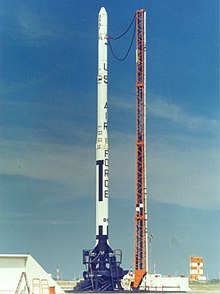 Blue Scout II rocket | |
| Function | Expendable launch system Sounding rocket |
|---|---|
| Manufacturer | Vought |
| Country of origin | United States |
| Size | |
| Height | 24 metres (79 ft) |
| Diameter | 1.02 metres (3 ft 4 in) |
| Mass | 16,874 kilograms (37,201 lb) |
| Stages | Four |
| Capacity | |
| Payload to LEO | |
| Mass | 30 kilograms (66 lb) |
| Associated rockets | |
| Family | Scout |
| Launch history | |
| Status | Retired |
| Launch sites | Canaveral LC-18B |
| Total launches | 3 |
| Success(es) | 2 |
| Failure(s) | 1 |
| First flight | 1961-03-03 |
| Last flight | 1961-11-01 |
| First stage – Algol 1B | |
| Powered by | 1 solid |
| Maximum thrust | 471 kilonewtons (106,000 lbf) |
| Specific impulse | 236 sec |
| Burn time | 40 seconds |
| Propellant | Solid |
| Second stage – Castor 2 | |
| Powered by | 1 TX-354-3 |
| Maximum thrust | 286 kilonewtons (64,000 lbf) |
| Specific impulse | 247 sec |
| Burn time | 27 seconds |
| Propellant | Solid |
| Third stage – Antares 1A | |
| Powered by | 1 X-254 |
| Maximum thrust | 60 kilonewtons (13,000 lbf) |
| Specific impulse | 256 sec |
| Burn time | 39 seconds |
| Propellant | Solid |
| Fourth stage – Altair 1A | |
| Powered by | 1 X-248A |
| Maximum thrust | 14 kilonewtons (3,100 lbf) |
| Specific impulse | 255 sec |
| Burn time | 40 seconds |
| Propellant | Solid |
The RM-90 Blue Scout II was an American sounding rocket and expendable launch system which was flown three times during 1961.[1][2][3] It was a member of the Scout family of rockets.[4] Blue Scout II was a military version of the NASA-operated Scout X-1, with adjustments to the payload fairings, engine nozzles and fins.[1][3]
Blue Scout II had a total length of 21.65 m and a finspan of 2.84 m.
It was capable of sending a 30 kg payload to a 300 km orbit at 28.00 degrees.[1] It was a four stage vehicle, with the following engines:[1][2][3][5]
- Stage 1: Algol 1B, solid propellant;
- Stage 2: Castor 2 (TX-354-3), solid propellant;
- Stage 3: Antares 1A (Star 31/X-254), solid propellant;
- Stage 4: Altair 1A (X-248), solid propellant.
Blue Scout II was used for two HETS test flights, and the launch of the Mercury-Scout 1 satellite for NASA.[1][2][6] This rocket and RM-89 Blue Scout I were replaced by Blue Scout Junior.[3]
Blue Scout II parameters
[edit]| Parameter | 1st Stage | 2nd Stage | 3rd Stage | 4th Stage |
|---|---|---|---|---|
| Gross Mass | 10,705 kg | 4,424 kg | 1,225 kg | 238 kg |
| Empty Mass | 1,900 kg | 695 kg | 294 kg | 30 kg |
| Thrust | 470 kN | 259 kN | 60.5 kN | 12.4 kN |
| Isp | 214 s (2.10 kNs/kg) | 262 s (2.57 kNs/kg) | 256 s (2.51 kNs/kg) | 256 s (2.51 kNs/kg) |
| Burn time | 40 s | 37 s | 39 s | 38 s |
| Length | 9.12 m | 6.04 m | 3.38 m | 1.83 m |
| Diameter | 1.01 m | 0.79 m | 0.78 m | 0.46 m |
| Engine: | Aerojet General Algol 1 | Thiokol XM33 (TX-354-3) Castor 2 | Allegany Ballistics Lab X-254 Antares 1A | Allegany Ballistics Lab X-248 Altair 1 |
| Propellant | Solid | Solid | Solid | Solid |
Launches
[edit]All three Blue Scout II launches occurred from Launch Complex 18B at the Cape Canaveral Air Force Station, the same launch pad used for the Blue Scout I.[1][2]
The first two launches were successfully conducted on 3 March and 12 April 1961 respectively, using vehicles D-4 and D-5.[1][2][7] They both carried HETS A2 plasma research experiments on suborbital trajectories.
The third launch was conducted on 1 November, using vehicle D-8, with the Mercury-Scout 1 satellite for NASA, which was intended to reach low Earth orbit.[6] The launch failed after the rocket went out of control, and was destroyed by the range safety officer 43 seconds after liftoff.[1][2]
| Date | Serial | Agency | Orbit | Mission Description |
|---|---|---|---|---|
| 1961 March 3 | D-4 | USAF | Suborbital, 2540 km apogee[7] | HETS A2-1 plasma mission |
| 1961 April 12 | D-5 | USAF | Suborbital, 1931 km apogee[7] | HETS A2-2 plasma mission |
| 1961 November 1 | D-8 | USAF | 373 km × 643 km, 32.5° (planned)[6] | Mercury-Scout 1 (failure) |
References
[edit]- ^ a b c d e f g h Mark, Mark. "Blue Scout II". Encyclopedia Astronautica. Retrieved 2024-09-28.
- ^ a b c d e f Gunter, Krebs. "Blue Scout-2". Gunter's Space Page. Retrieved 2024-09-28.
- ^ a b c d Parsch, Andreas (2003). "Ford RM-90 Blue Scout II". Directory of U.S. Military Rockets and Missiles - Appendix 1: Early Missiles and Drones. Retrieved 2024-09-28.
- ^ Krebs, Gunter. "Scout (Algol-1, -2 based)". Gunter's Space Page. Retrieved 2024-09-28.
- ^ "Antares 1A". www.astronautix.com. Retrieved 2024-09-28.
- ^ a b c "Mercury-Scout 1 (MS 1, MNTV 1)". Gunter's Space Page. Retrieved 2024-09-28.
- ^ a b c McDowell, Jonathan. "Orbital & Suborbital Launch Database - Scout". Jonathan's Space Page. Archived from the original on 2020-08-11.
